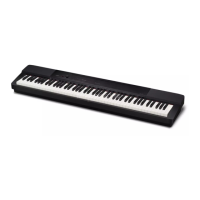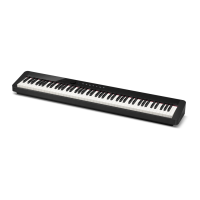English
Connections
EN-7
Connecting to a Musical Instrument
Amplifier 2
Use commercially available cables to connect the
amplifier to the Digital Piano’s LINE OUT jacks as
shown in Figure 2. LINE OUT R jack output is right
channel sound, while LINE OUT L/MONO jack
output is left channel sound. Connecting to the LINE
OUT L/MONO jack only outputs a mixture of both
channels. It is up to you to purchase connecting cable
like the one shown in the illustration for connection of
the amplifier. Use the Digital Piano’s VOLUME
controller to adjust the volume level.
IMPORTANT!
• When using the LINE OUT jacks, also connect
headphones to the PHONES jack. This will switch
the LINE OUT output to appropriate sound quality.
Connecting the supplied pedal (SP-3) to the DAMPER
PEDAL jack makes it possible to use the pedal as a
damper pedal.
Pressing the damper pedal while playing will cause the
notes you play to reverberate for a long time.
• When a GRAND PIANO tone (CONCERT,
MODERN, CLASSIC, MELLOW, BRIGHT) is
selected as the tone, pressing this pedal will cause
notes to reverberate just like the damper pedal on an
acoustic grand piano.
Pedal Connector
You can connect the optionally available 3-Pedal Unit
(SP-33) to the pedal connector on the bottom of the
Digital Piano. You can then use the pedals for
expression that is similar to that available on an
acoustic piano.
SP-33 Pedal Functions
z Damper Pedal
In addition to the damper pedal functions described in
the column to the left, the SP-33 pedal also supports
half-pedal operation, so pressing the pedal part way
applies only a partial damper effect.
z
Soft Pedal
Pressing this pedal suppresses notes played on the
keyboard after the pedal was pressed, and makes them
sound softer.
z Sostenuto Pedal
Only the notes that are played while this pedal are
depressed are sustained until the pedal is released.
NOTE
• The optional CS-67P stand is required in order to use
the SP-33 Pedal Unit.
Disabling Damper Noise Output
Damper noise is a slight metallic ringing sound that is
generated as the damper of an acoustic piano separates
from the wires pedal when the damper pedal is
pressed. The damper resonance of your Digital Piano
normally includes damper noise, but you can perform
the procedure below to disable its output.
1.
While holding down the FUNCTION button,
press the Damper Noise keyboard key (page
EN-21).
• Each press of the key toggles the setting and causes
the Digital Piano to beep as described below.
– Long beep: Damper noise output disabled
– Short beep: Damper noise output enabled
• See “Damper noise” on page EN-22 for more
information.
Connecting a Pedal
DAMPER PEDAL jack
SP-3
Back
Pedal connector
Bottom
Soft Pedal
Sostenuto Pedal
Damper Pedal
PX160-ES-1B.indd 9 2016/01/20 17:58:30

